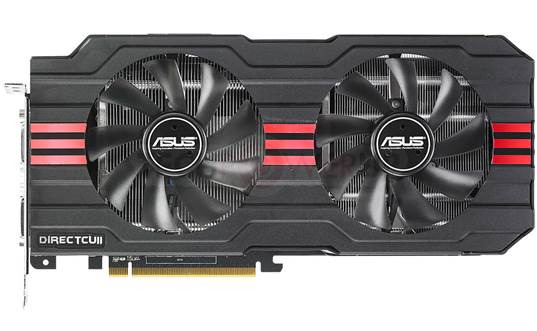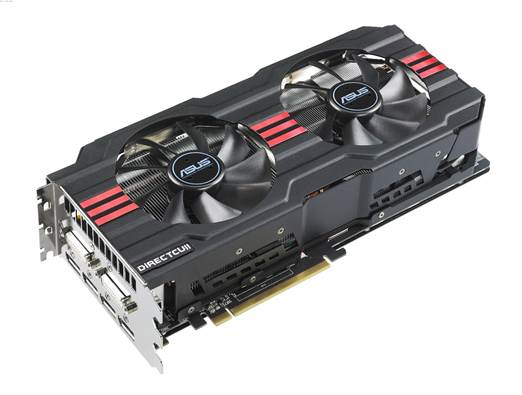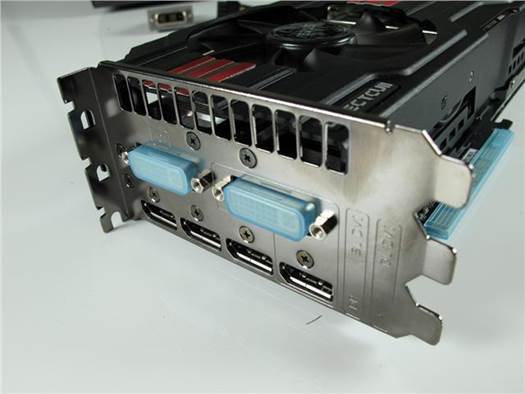ASUS Radeon HD 7970 Directcu II Top
In the game of high-stakes poker known as
the GPU industry, once a manufacturer reveals its hand, it then waits for the
competition to do the same. If the competing manufacturer reveals a more
powerful or desirable alternative, due to a combination of price, performance,
noise, or all three, the other manufacturer will oftentimes update its lineup
with a new Extreme Titanium Platinum FTW Balls-to-the-Wall Edition, which is
usually mildly overclocked. We've seen both Nvidia and AMD do this in the past,
but in this particular round it's been AMD pulling this maneuver with its GHz
edition of the HD 7970. The original HD 7970 shipped with a 925MHz core clock
speed, and in order to gain a bit of an edge on the suddenly dominant GeForce
GTX 680, or at least attempt to match its performance, AMD overclocked its
flagship board to 1GHz and released the Radeon-based Kraken. It achieved its
goal, too, as the GHz edition of the card was. for the most part, as fast as
the GTX 680, or at least the two were close enough to move the argument away
from performance to price and other considerations. Unfortunately for AMD, once
people began to consider other factors, such as noise and heat, Nvidia still
held the edge with its power-sipping Kepler architecture. While third-party manufacturers
can't do much about the card's power output, they could certainly change its
noise profile, and that’s exactly what Asus has done by adding its sizable
DirectCU II cooler to this card.

ASUS
Radeon HD 7970 Directcu II Top
If you want more details on this card's
cooler, go back and read the previous review of the GTX 680, as it has a
similar cooler, though the designs aren't exactly the same since the cards'
layouts are slightly different. The biggest difference is that the HD 7970
features an additional copper heat pipe for a total of six, in comparison to
the GTX 680’s five heat pipes, but both use 100mm fans and large aluminum
heatsinks. This is also a three-slot card (Asus specifies that it takes up 2.5
slots, so you could theoretically slide something extremely skinny in below
it), and it's comparable in size to the towering Power Color Devil 13 HD 7990
we reviewed last month, which features two HD 7970 Tahiti GPUs on a single PCB.
The HD 7970 DirectCU II TOP measures 11 inches long, 2.1 inches thick, and 5.1
inches deep. It requires two 8-pin power connectors, which compares to one
8-pin and one 6-pin connector on the standard design. It also includes support
for VGA Hotwire.

The
Asus HD 7970 DirectCU II TOP's triple slot design is an amazing thing to not
hear at all.
Like the GTX 680, this card is also
overclocked a bit and runs at 1,000MHz. which is 75MHz over its stock speeds.
Its memory also has a teeny, tiny overclock up to 1,400MHz from 1,375MHz. The
card includes four Display Port connectors along with one single-link DVI port
and one dual-link DVI port, giving it a distinct advantage in the
multiple-displays department, and allowing you to run all six displays using
AMD’s Eyefinity setup for multi-monitor gaming.

During testing, the Asus card showed a mild
advantage over the reference design, pulling a few frames per second out of its
red-and-black hat in each test. In two games in particular, though Dirt 3 and
Far Cry 2 we saw the most improvement, though in Metro we’re still stuck in the
sub-20fps region, which is simply ridiculous but not the fault of the cards,
obviously. Given its overclocked nature, it's not too surprising that it's
faster than the reference design, but what's most impressive is how utterly
silent the card is at all times; a marked improvement over the reference
design, and all other HD 7970s we’ve ever tested. Sadly, the Radeon card still
gets its lunch eaten by the GTX 680 in almost every benchmark, and not just by
one or two frames but by enough to make it clear which card is faster. As we
stated in the GTX review, it could be down to drivers, as we used the 12.10
drivers for these tests, which are the latest "official" drivers. The
12.11 drivers have been in beta for a while now and might have turned the tide
had they been released, but we don't test with beta drivers, so for now the
crown goes to the green camp. To be clear, this is the best version of the HD
7970 we've tested in this generation of cards, but given its performance
deficit to the GTX 680, we're forced to withhold a Kick Ass award for now.
Let's hope the company can reclaim one very soon with its HD 8000 series GPUs.